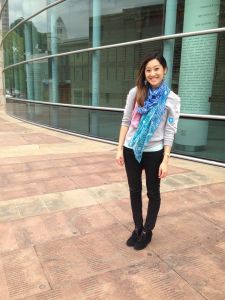
Children’s Courtyard engraving.
When eighth-grade teacher Staci Yamanishi visits JANM with her students, she takes them through Common Ground: The Heart of Community, our ongoing exhibition on the Japanese American experience, and Fighting for Democracy, our appointment-only interactive exhibit on civil rights. Before they leave to return to their classroom however, the students receive one very special bonus assignment: find their teacher’s name engraved on the JANM courtyard.
Since JANM’s Pavilion building was opened in 1999, the museum has engraved the names of its youngest constituents in the Children’s Courtyard. For JANM, the Courtyard is a way to connect to each new generation, with the hope that being a part of the museum in this way will inspire a lifetime of sharing and discovery. As the young visitors grow into adults, we hope that they will continue to return to this institution and feel that they are a part of this community.
For Staci, the engraving was a gift from her grandparents. She remembers coming to the museum with her parents when she was young to look at her name, and she has returned many times over the years. She remembers visiting JANM on a school trip in the eighth grade and again when she was a student in UCLA’s Teacher Education Program.

engraved on JANM’s Children’s Courtyard.
Museum staff began getting to know Staci during her UCLA years, and soon after, she contributed a poem titled “I Come from Many Memories” to JANM’s experimental exhibition Xploration Lab 2012, which explored issues of identity. Staci has also served on an educator committee, which the museum’s Education Unit convenes on occasion to help brainstorm ways JANM can better serve teachers and students.
Now, in addition to occasional visits with her family, Staci returns every year on an eighth grade field trip—no longer as a student, but as a teacher. When asked why she brings her students to JANM, she replies that it’s important to her that the students understand her history—a unique history that is not found in their textbooks.

Much of Yamanishi’s knowledge of her history comes from conversations she had with her grandfather before he passed away. Having served in the 442nd Regimental Combat Team while his wife (Staci’s grandmother) was incarcerated at Manzanar, he was an advocate of sharing the Japanese American World War II experience. He ingrained in Staci the importance of being proud of one’s history and passing it on to the next generation. Now, as a teacher herself, she encourages her students to explore their own stories through family history projects.
JANM is proud to know Staci and we are thankful for people like her, who share our mission to promote understanding and appreciation of America’s ethnic and cultural diversity by sharing the Japanese American experience.
If you are interested in purchasing an engraving for a child or youth (21 and under) in your life, visit our Children’s Courtyard Engraving page for complete details.








































